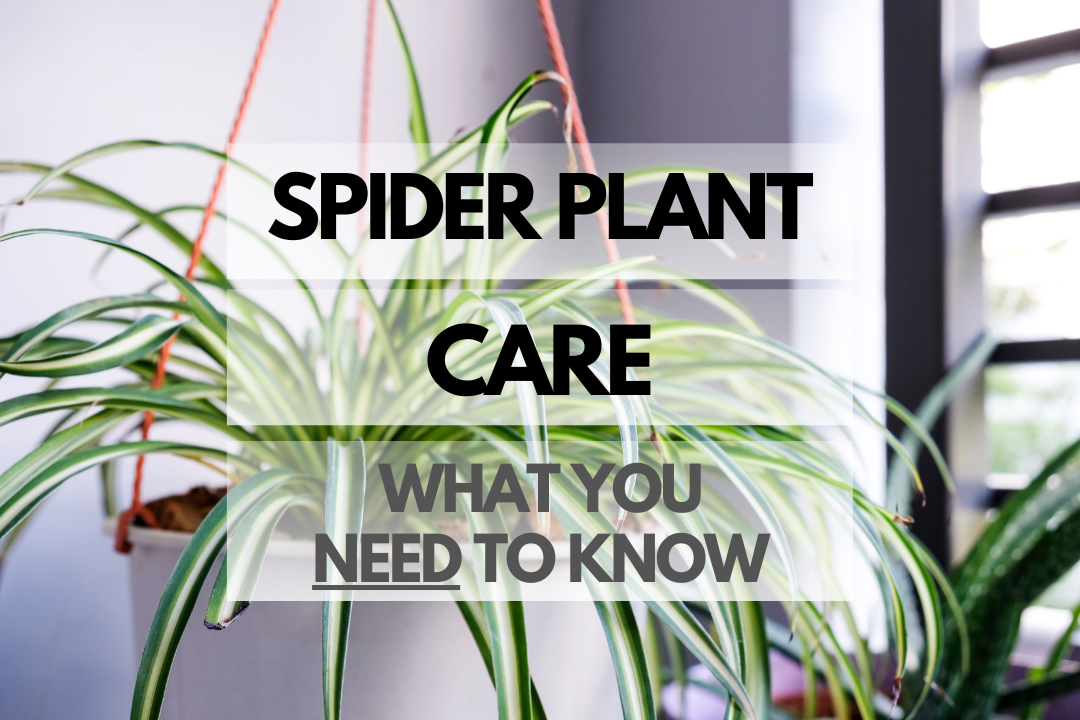Welcome to the wonderful world of spider plants! These adaptable, easy-to-grow plants are perfect for beginners and experienced plant enthusiasts alike. In this guide, we’ll cover everything you need to know about spider plant care, from sunlight requirements to common problems. Let’s get started!
Spider Plant Care Guide
Quick Reference Table: Caring for Spider Plants
| Aspect | Details |
|---|---|
| Sunlight | Bright, indirect light |
| Soil | Well-draining, all-purpose potting mix |
| Watering | Water when the top inch of soil is dry |
| Pruning | Trim off dead leaves and spent flower stalks |
| Temperature | 60-75°F (15-24°C) |
Spider Plant Sunlight: Do They Need It and How Much?
Spider plants thrive in bright, indirect light. While they can tolerate lower light conditions, their growth may be slower and less vibrant. Avoid placing your spider plant in direct sunlight, as this can cause the leaves to scorch and turn brown.
Spider Plant Soil Tips
A well-draining, all-purpose potting mix is best for spider plants. To improve drainage, you can also add some perlite or coarse sand to your potting mix. Make sure to choose a pot with drainage holes to prevent overwatering and root rot.
Spider Plant Watering and Frequency
Spider plants prefer to dry out slightly between waterings. Water your spider plant when the top inch of soil feels dry to the touch. Be careful not to overwater, as this can lead to root rot and other problems. Spider plants are somewhat drought-tolerant and can bounce back from occasional underwatering, so it’s better to err on the side of caution.
Pruning Spider Plants Properly
Pruning is essential for maintaining a healthy and attractive spider plant. Trim off dead leaves and spent flower stalks to keep your plant looking its best. You can also remove the baby spider plants, or “spiderettes,” to control the size of your plant or propagate new plants.
Optimal Spider Plant Temperature: Can They Tolerate the Cold?
Spider plants prefer temperatures between 60-75°F (15-24°C) and can be sensitive to cold drafts or sudden temperature changes. Keep your plant away from drafty windows and air conditioning vents to ensure a stable temperature. While spider plants can tolerate brief periods of cold, prolonged exposure to temperatures below 50°F (10°C) can harm the plant.
Common Spider Plant Problems
Brown Leaf Tips
Brown leaf tips are a common issue for spider plants and can be caused by several factors, including overwatering, underwatering, or exposure to chemicals in tap water. To avoid this issue, monitor your plant’s watering needs closely and consider using filtered water or rainwater for watering.
Root Rot
Overwatering can lead to root rot, a potentially fatal problem for spider plants. Prevent root rot by allowing the top inch of soil to dry between waterings, providing proper drainage, and using a well-draining potting mix.
Pests
Spider plants can occasionally attract pests like spider mites, aphids, or mealybugs. Inspect your plant regularly for signs of infestation, and treat any problems promptly with insecticidal soap or neem oil.
Spider Plant Outdoors vs Indoors
Spider plants can grow both indoors and outdoors, depending on your climate and preferences. Here’s a quick pros and cons list to help you decide where to grow your spider plant:
| Indoors | Outdoors |
|---|---|
| Easy to control growing conditions | Can provide a lush, green accent in the garden |
| Less prone to pests anddiseases | Larger space for growth and spreading |
| Can be used to improve indoor air quality | More access to natural sunlight and rainwater |
| Not suitable for outdoor climates with freezing temperatures | May require more frequent watering and care |
Best Pots for Spider Plants
When choosing a pot for your spider plant, consider the following factors:
- Drainage: Make sure your pot has drainage holes to prevent overwatering and root rot.
- Size: Choose a pot that is 1-2 inches larger in diameter than the current pot. Spider plants like to be slightly root-bound, so avoid choosing a pot that is too large.
- Material: Terracotta pots are a popular choice for spider plants because they provide excellent drainage and help regulate soil moisture. However, plastic and ceramic pots can also work well as long as they have drainage holes.
Spider Plant Facts
Spider Plant Benefits
- Air Purification: Spider plants are known for their ability to remove pollutants from the air, such as formaldehyde and benzene, making them a healthy addition to your home or office.
- Low Maintenance: Spider plants are easy to care for, making them an excellent choice for both beginner and experienced plant enthusiasts.
- Adaptable: Spider plants can tolerate a wide range of growing conditions, making them suitable for various environments.
- Attractive Foliage: With their arching leaves and cascading baby plants, spider plants make a beautiful and eye-catching addition to any space.
Growth Rates: How Fast Do They Grow?
Spider plants grow relatively quickly under favorable conditions. On average, they can grow up to 12 inches (30 cm) in a year. However, growth rates can vary depending on factors such as light, temperature, and overall care.
Spider Plant Lifespan
With proper care, spider plants can live for several years. These hardy plants are known for their longevity, and it’s not uncommon for them to last for a decade or more when given the right conditions.
Are Spider Plants Safe?
Spider plants are considered non-toxic to humans and pets, including cats and dogs. This makes them a popular choice for households with children and furry friends. However, it’s always a good idea to keep plants out of reach to prevent accidental ingestion or damage to the plant.
Spider Plant Flowers
Spider plants produce small, white flowers on long, arching stems. These flowers are usually followed by the appearance of baby spider plants, or “spiderettes,” which can be propagated to create new plants.
Spider Plant Types and Varieties
Chlorophytum comosum ‘Vittatum’
This classic variety of spider plant features long, arching green leaves with a bold white stripe down the center. It produces baby spider plants on long, dangling stems, creating a cascading effect.
Chlorophytum comosum ‘Variegatum’
This variety has green leaves with white edges, creating a more subtle variegation compared to the ‘Vittatum’ variety. The ‘Variegatum’ spider plant is also known for its attractive, arching foliage and baby spider plants.
Chlorophytum comosum ‘Bonnie’
The ‘Bonnie’ spider plant is characterized by its curly, twisted leaves and a central white stripe. This unique variety adds an interesting visual texture to any space and produces baby plants just like the other varieties.
Spider Plant Pros and Cons
| Pros | Cons |
|---|---|
| Easy to care for | Prone to brown leaf tips |
| Non-toxic to pets and humans | May require regular pruning |
| Adaptable to various growing conditions | Can become invasive if not controlled |
| Excellent air purifier | Requires repotting as it grows |
Spider Plant Cost
Spider plants are generally affordable, with prices ranging from $5 to $20, depending on the size and variety. Smaller plants will be cheaper, while larger, more established plants may cost more.
Where to Buy Spider Plants
Spider plants are widely available and can be found at local nurseries, garden centers, and even big-box stores. Online retailers also offer a variety of spider plants, often with convenient shipping options.
Is Spider Plant Propagation in Water Possible?
Yes, spider plant propagation in water is possible and quite easy. Simply detach a baby spider plant, or “spiderette,” from the mother plant and place it in a container of water. Within a few weeks, roots should begin to grow. Once the roots are established, you can transfer the spiderette to a pot with soil.
Additional Resources
- ASPCA: Spider Plant
- Gardening Know How: Spider Plant Care
- Facebook Group: Houseplant Hobbyist
- Reddit Community: r/houseplants
- Book: The Houseplant Handbook by David Squire
FAQ for Spider Plant Care
Are Spider Plants toxic to cats?
No, spider plants are non-toxic to cats. However, it’s still a good idea to keep plants out of reach to prevent any accidental ingestion or damage to the plant.
Are Spider Plants toxic to dogs?
No, spider plants are non-toxic to dogs. Just like with cats, it’s best to keep plants out of reach to avoid any issues.
Are Spider Plants toxic to kids?
Spider plants are considered non-toxic to humans, including children. Keeping plants out of reach of young children is still recommended to prevent any accidental ingestion or damage to the plant.
How tall do Spider Plants get?
Spider plants can grow up to 12 inches (30 cm) tall, with a similar spread. The long, arching leaves and cascading baby plants create an attractive, full appearance.
Can Spider Plants live outside?
Spider plants can be grown outside in mild climates, as long as they are protected from direct sunlight and extreme temperatures. In colder climates, spider plants can be moved outside during the warmer months but should be brought indoors before the first frost.
Are Spider Plants poisonous?
No, spider plants are not poisonous. They are considered non-toxic to humans and pets, making them a safe addition to most households.

